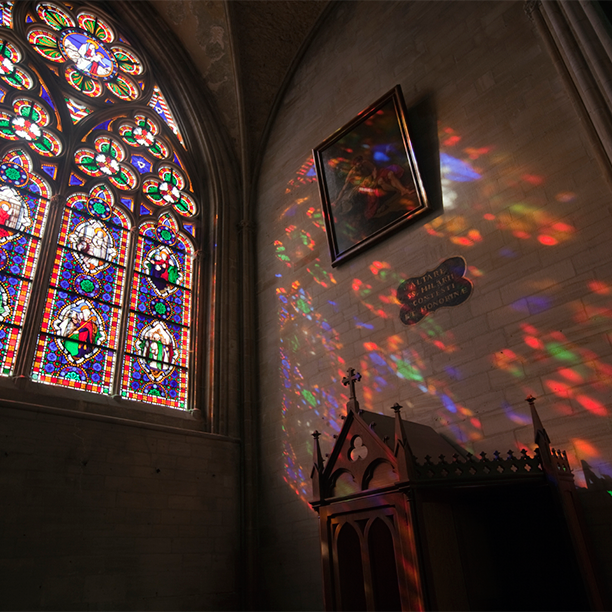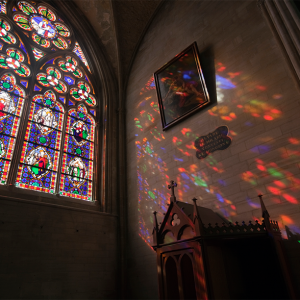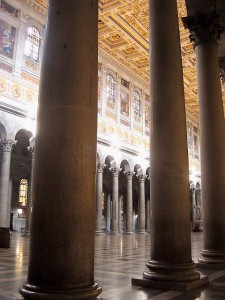Most Catholics are unaware of how our traditional church buildings are based on designs given by God himself. Designs that stretch all the way back to Mount Sinai when God set forth the design for the sanctuary in the desert and the tent of meeting. Many of the fundamental aspects of our church layouts still follow that plan and the stone version of it that became the Jewish Temple in Jerusalem. Our traditional church buildings also have numerous references to the Book of Revelation and the Book of Hebrews, both of which describe the heavenly liturgy and heaven itself.
There is not time to develop these roots at length in this post today, though I hope to do so in a series of future posts.
Sadly in recent decades there was a casting off of these biblical roots in favor of a “meeting house” approach to church design. No longer was the thinking that our churches should reflect heavenly realities, teach the faith, and follow biblical plans. Rather the thinking was that the Church simply provided a space for the people to meet and conduct various liturgies.
In some cases the liturgical space came to be considered “fungible” in that it could be reconfigured to suit various needs: Mass today, concert tomorrow, spaghetti dinner on Wednesday. This thinking began to be set forth as early as the 1950s. Pews were often replaced by chairs which could be moved to suit various functions. And even in parishes which did not go so far as to allow spaghetti dinners in the nave, (mine did in the 1970s), the notion of a church as essentially a meeting space prevailed.
Thus churches looked less and less like churches and more like meeting halls. Bare essentials such as an altar, pews or chairs, a pulpit and very minimal statuary were used, but the main point was simply to provide a place for people to come together. There was very little sense that the structure was to reflect heaven or even remind us of it.
That is beginning to change as newer architects are returning more and more to sacred and biblical principles in church design. Further, many Catholics are becoming more educated on the meaning of church art as something beyond what is merely “pretty,” and coming to understand the rich symbolism or art and architecture as revealing the faith and expressing heavenly realities.
Take stained glass for instance. Stained glass is more than just pretty colors, pictures and symbols. Stained glass was used for centuries to teach the faith through picture and symbol. Until the past 200 years most people, even among the upper classes, could not read well, or at all. How does the Church teach the faith in such a setting? Preaching, art, passion plays, statues, and stained glass.
Stained glass depicted biblical stories, saints, sacraments, and glimpses into heaven. Over the centuries a rich shorthand of symbols also developed: crossed keys = St. Peter, a sword = St. Paul, a large boat = the Church, shell = baptism, and so forth. And so the church taught the faith through the exquisite art of stained glass.
But stained glass also served another purpose, that of imaging the foundational walls of heaven. For, recall that traditional church architecture saw the church as an image of heaven. Hence it’s design was based on the descriptions of heaven found in the Scriptures. Now among other things, heaven is described in the Book of Revelation as having high walls with rows of jewels embedded in the foundations of those walls:
One of the seven angels…showed me the Holy City, Jerusalem, coming down out of heaven from God. It shone with the glory of God, and its brilliance was like that of a very precious jewel, like a jasper, clear as crystal. It had a great, high wall with twelve gates….The foundations of the city walls were decorated with every kind of precious stone. The first foundation was jasper, the second sapphire, the third chalcedony, the fourth emerald, the fifth sardonyx, the sixth carnelian, the seventh chrysolite, the eighth beryl, the ninth topaz, the tenth chrysoprase, the eleventh jacinth, and the twelfth amethyst.... (Revelation 21:varia)
Thus, because heaven had great high walls, older churches almost always had a lot of verticality. The lower foundational walls gave way to the higher clerestory, and above the clerestory the vaults of the ceiling rise even higher. And in the lower sections of the walls, extending even as high as the clerestory, the jewel-like stained glass recalls the precious jeweled gemstones described in the lower walls of heaven, according to Revelation 21.
The compelling effect of a traditional church is to say to the believer, you are in heaven now. In my own parish church, the floors are a green jasper color, and the clerestory walls, red jasper. On the clerestory are painted the saints gathered before the throne-like altar in heaven (Heb 12:1; Rev. 7:9) . In the apse is the throne like altar, with Jesus at the center (Rev 5:6), the seven lamp stands are surrounding him in seven candles (Rev 4:5). In the stained glass of the transept are 12 apostles, joined with the 12 patriarchs symbolized by 12 wooden pillars. Together they form the 24 elders who surround the throne in heaven (Rev 4:4). Above the high altar in the clerestory windows are the four living creatures also said to surround the throne (Rev 4:6-7).
Yes, amazing. I stand in my church and realize its message: you are in heaven when you enter here and celebrate the sacred mysteries: sursum corda! (hearts aloft)!
Photo above: San Chapelle, Paris France
Here’s a video I put together on stained glass. Enjoy these jewels of light that recall the lower walls of heaven as the choir sings Christe Lux mundi (O Christ you are the Light of the world).
The Sources of many of the photos in this video are:
http://www.romeofthewest.com
http://viewfrombackpew.blogspot.com/
–
Also if you are interested, here is a video I did some time back featuring some of the architectural details of my own parish.
–



